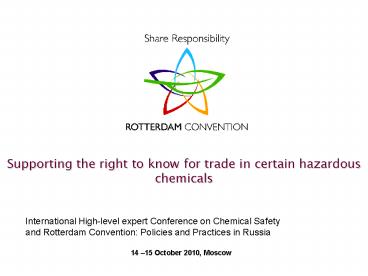OPERATION OF THE PIC PROCEDURE - PowerPoint PPT Presentation
Title:
OPERATION OF THE PIC PROCEDURE
Description:
Title: OPERATION OF THE PIC PROCEDURE Author: Wyrwal, Gerold (AGPP) Last modified by: Office 2004 Benutzer Created Date: 3/3/2006 10:28:22 AM Document presentation format – PowerPoint PPT presentation
Number of Views:59
Avg rating:3.0/5.0
Title: OPERATION OF THE PIC PROCEDURE
1
Supporting the right to know for trade in certain
hazardous chemicals
International High-level expert Conference on
Chemical Safety and Rotterdam Convention
Policies and Practices in Russia 14 15 October
2010, Moscow
2
Objective
- To promote shared responsibility and cooperative
efforts among Parties in the international trade
of certain hazardous chemicals in order to
protect human health and the environment from
potential harm and to contribute to their
environmentally sound use
3
Global status of ratifications
4
Scope of the Convention
- Applies to
- Chemicals banned or severely restricted to
protect human health or the environment - Severely hazardous pesticide formulations (SHPF)
- causing problems under conditions of use in
developing countries or countries with economies
in transition
5
NOTE
- Not a ban!
6
Key Provisions
- PIC procedure
- - Supports decision-making for importing
countries - - Seeks compliance from exporting Parties
- Information exchange
- - Sharing information on potentially
hazardous chemicals - - Provides the basis for decisions on
future imports and - exports of chemicals (PIC procedure)
7
Key Players
- Designated National Authorities (DNAs)
- Conference of the Parties (COP)
- Chemical Review Committee (CRC)
- Secretariat
8
SUMMARY of the PIC procedure
- Party submits final regulatory action
information shared
- 2nd regulatory action triggers CRC review
S E C R E T A R I A T
- CRC recommends chemical for listing
Reviews information
- COP lists chemical - Annex III
Country
Distribution to all DNAs
Decision Guidance Document
Replies to the country
Informs all of decision (PIC Circular)
Takes an import decision (interim or final)
PIC CIRCULAR (Appendix IV) by chemical- import
responses from countries- failure list
countries not having submitted a response
9
Benefits
- 1. Secretariat facilitates dialogue
- Brings country together with partners prior to
ratification - Greater understanding on trade issues facilitated
10
Benefits
- 1. Facilitates trade
- Supports a country to import
- Improves relations between trading countries
- Legal framework on trade levels the playing
field
11
Benefits
- 1. Prevents unwanted trade
- PIC procedure is legally binding on Parties
- Importing Parties make informed decisions on
trade - Exporting Parties avoid sending unwanted
chemicals Parties
12
Benefits
- 2. Early warning system
- PIC circular provides information on regulatory
actions globally - Also information on incidents of health impacts
for SHPF - Decision Guidance Documents supports decision
making
13
Benefits
- 4. Export notification
- Reminds importing Parties of a national
regulatory action in the country of the exporting
Party - Informs importing Parties that the chemical may
be in use in their country - Provides an opportunity to seek further
information from the exporting Party
14
Benefits
- 5. Information accompanying export
- Support for implementation of GHS labelling and
data sheets - HS Codes facilitate tracking PIC chemicals
15
Benefits
- 6. Network of DNAs
- Access to DNAs in other countries with similar
conditions - Opportunities to exchange experience and
information
16
Benefits
- 7. Technical Assistance
- Parties cooperate in developing infrastructure
and capacity - Access to GEF financial support
- Strengthen capacity of Parties to assess risks
associated with industrial chemicals - Development of National Chemicals Profiles
17
Trade by consent
NOTE again
- A ban is not meant
18
The Right to Know































